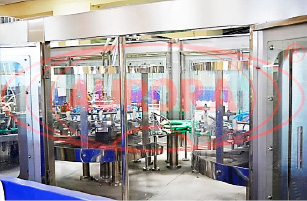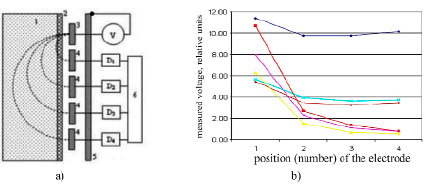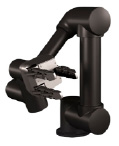The growth in the consumption of alcoholic beverages and increased competition in this market contributed to the development and modernization of most modern vodka factories.
First of all, modernization affected such an important element of alcohol production as bottling lines [1]. Currently, the managers of many alcohol enterprises have realized that the modernization of this equipment will not only increase the level of production, but also contribute to the introduction of new packaging and labels, which, of course, have a huge impact on a potential customer. It has been proven that products with an intricate packaging shape and a bright label will be much more popular.
The purpose of the study. It is very important to improve the methods and means of quality control and safety of packaged beverages produced. In this regard, the purpose of this study, in addition to analyzing existing liquid product bottling lines, was the system synthesis of a model of a stationary automated control complex (SACC), which allows for continuous quality control of packaged alcoholic beverages from the manufacturer, in order to develop a portable automated express control complex (PAECC) on its basis, without opening the container – for chain stores and supervisory authorities, for to protect consumers from low-quality and counterfeit alcoholic beverages.
A filling line is a complex of automatic or semi – automatic equipment (machines and devices) interconnected by a conveyor and operating in a general mode. The full cycle of the filling line processes includes rinsing containers, directly filling liquids, capping, labeling and group packaging [2].
The main element of the automated filling line are the so-called “triblocks”. The filling triblock is a technologically automated machine that combines three functions: rinsing containers, filling (dosing) and capping with a cork. The operation of its components is more stable and more cost-effective [2].
For example, the “Master” MZ-400ED (Fig. 1) is a rotary-type filling triblock for the production of large batches of products [3].
The triblock for bottling vodka “Master” was developed by specialists of the AURORA Plant specifically for companies that sell the production of alcohol-containing liquids, allowing you to organize a full cycle of bottling alcoholic beverages, implementing all processes promptly and with high efficiency. The capacity of the triblock is up to 15,000 bottles/hour (4 bottles per second). The triblock consists of 30 rinse aid grips, 32 gravity dispensers and 4 capping heads with inert gas injection and allows the production of large batches of high-quality product with minimal deviations from standards [3].
The existing methods of analysis and examination of packaged alcoholic beverages have significant drawbacks, the main of which is the lack of continuous control of the contents of each bottle, as well as the need to withdraw goods from the batch and sampling, including the complexity of the analysis (compliance with special conditions, the use of special equipment and reagents, etc.). In order to identify counterfeit products, it is necessary to develop a model of an automated system of continuous express control of alcoholic beverages, which, for example, should consist of a lid-sensor on a container and an automated express control complex without opening the container.

Fig. 1. Appearance of the triblock MZ-400ED
At the same time, defective or/and counterfeit products can be detected by deviations of kinematic viscosities and densities at standard temperatures, underflow/overflow, viscosity index and solidification temperatures [4].
This system must meet the following requirements:
- The time spent on sample analysis should be significantly less than the time of standard methods;
- the accuracy of diagnosing alcoholic beverages for forgery should not be inferior to standard methods;
- the diagnosis of the sample should take place without opening the container;
- the possibility of continuous control of each unit of production.
To optimize the process of product control and the implementation of continuous express control, an adaptation of the method of weight impedance electrometry (WIEM), as well as models of stationary and portable automated complexes, for use in manufacturing enterprises, trading firms and supervisory authorities is proposed [4,5].
Knowing the mass of an empty bottle, it is possible by weighing, without opening the stoppers and without sampling, to determine the density of the liquid, pi, g/m3, in its according to the formula (1) [6]:
 (1)
(1)
where Pi is the measured weight of the i-th sample in a packed container, kg; Pj is the weight of the i-th reference container, kg; Vij is the reference volume of the container.
At the same time, the values of densities at different temperatures are calculated according to the formula of D.I. Mendeleev [6]:

 (2)
(2)
where  – temperature correction of density by one degree; t – the desired temperature, °C; pT, p293 – the density of product at the current temperature and at 20°C.
– temperature correction of density by one degree; t – the desired temperature, °C; pT, p293 – the density of product at the current temperature and at 20°C.
Measurements using a dual coaxial sensor of two capacitances (Sdn and Sdv) and two tangents of the loss angle (tgδdn, tgδdv), allow us to calculate the average value of the relative permittivity (ε) of an alcoholic beverage, and in the presence of reference data (τe, ηe), – to determine the dynamic viscosity of the sample (ηо), through the calculation of its microscopic (τо) and macroscopic relaxation times (τ), and then kinematic viscosity (ν) [6]:
 (3)
(3)
 (4)
(4)
 (5)
(5)
 (6)
(6)
where C0 – is the capacity of the sensor in the air; Сizm – is the capacity of the sensor cap; η0 – is the dynamic viscosity; τ and τ0 – are macroscopic and microscopic relaxation times; ω is the cyclic frequency; ηэ and τэ – are tabular air data uploaded to the computer.
 . (7)
. (7)
The dependence of kinematic viscosity on temperature can be calculated using the Walter formula [6]:
 (8)
(8)
where the empirical coefficients a and b are determined by the known pairs of values v and T according to the formulas [6]:
 (9)
(9)
At the same time, in order to more accurately determine the quality and/or counterfeit of alcoholic beverages,
firstly, the specific active electrical conductivity of the liquid is measured in the frequency range from 1 kHz to 15 MHz for two different temperatures in the range from the boiling point to the freezing point of the liquid and at the intersection of the dependences of the specific active electrical conductivity on the frequency, the characteristic frequency of the investigated liquids;
thirdly, by measuring the capacitances of the lid sensors at a frequency of 1 kHz and at a frequency of 1 MHz (in the air – С01kHz and С01MHz), and then (when turning the container) in the packaged alcoholic product (СН1kHz и СН1MHz), the calculated relative differences characterizing the increment of the dielectric constant (Δεt), the mass fraction is determined water in this container as a percentage according to the following formulas [5,6]:
∆εt = СН1kHz / С01kHz – СН1MHz / С01MHz (10)
ХН2О = ∆εt/kε,t (11)
where kε,t = kε,20+m2 ⋅ (20-t) и kε,20 – concentration coefficients (at appropriate temperatures).
Taking into account the performance of filling lines (1-4 bottles per second), as well as the fact that before capping, the “checkweyer” (the module for measuring the amount of product in a container) can transfer the volume of liquid product in each container to the SACC, the productivity of the SACC can be dramatically increased if the LQtest 3.0 device is installed on the “checkweyer”, which contactless in 0.5 seconds, it will measure and transmit data on the permittivity and electrical conductivity of the liquid product in each container via Wi-Fi to the SACC. This will allow you to “remove the load” from the E7-29, leaving quick control measurements at the above reference and characteristic frequencies [7].
The PC must be of industrial design with a performance sufficient to provide calculations according to the specified formulas (1-11) within 1 second and print out the “image”/certificate of each liquid product in a container (tab. 1).
The need for instantaneous heating at 5 and 10 degrees Celsius of the already packaged beverage being tested during measurements and calculations at frequencies of 1 kHz and 1 MHz according to the above formulas (10,11), as well as for further calculation of the characteristic frequency, suggests the following solutions:
- first, it is possible to equip the SACC with a microwave device (oven) of the corresponding container dimensions and power
- secondly, to use an inductive sensor-cover, which was developed for precision measurements with direct current heating of a part of the liquid product (in the lid) during measurements on alternating current.
In this case, when solving the impedance equation, it becomes possible to “use” all similarity criteria for identification [6]:
The conductivity ratios in liquids are described by Ohm’s laws (Z, G, R, I) and are determined by impedance analyzers and immitance meters. In addition to determining the specific parameters of samples and standards, the basic equation of the characteristic impedance can be used [6]:
 (12)
(12)
By solving the impedance equation (9), it is possible to obtain additional parameters for sample identification, in particular, for determining the magnetic permeability of the beverage according to the formula [6]:
 (13)
(13)
where μ0 is the magnetic constant; S is the surface area of the electrode, m2; l is the distance between the measuring electrodes, and the other designations are the same.
Table 1
“Product image” – certificate output form
|
№ |
Name of the parameter |
Designation |
Dimension |
Range of variation |
|
1 |
Weight |
m |
kg |
0,25 – 20 |
|
2 |
Volume |
V |
m3 |
(0,25 – 20) *10-3 |
|
3 |
Density |
ρ |
kg/ m3 |
0,5 – 2,0 |
|
4 |
Conductivity |
G |
cm (1/Om) |
0,2 – 0,000001 |
|
6 |
Capacity |
C |
pF |
1 – 10000 |
|
7 |
Dielectric conductivity |
ε |
F/m |
1 – 1200 |
|
8 |
Magnetic conductivity |
µ |
Hn/m |
10-1 – 10-6 |
|
9 |
Kinematic viscosity |
ν |
m2 /s |
10-5- 10-3 |
|
10 |
Dynamic viscosity |
η |
Pa∙s |
10-5- 10-4 |
|
11 |
Characteristic frequency |
f |
Hz |
2 kHz – 10 MHz |
|
12 |
Humidity |
% |
1 – 60 |

Fig. 2. LQtest 3.0 field structure (a) and sample graphs (b)
1 – the liquid to be tested, 2 – the vessel wall and the air gap, 3 – the active electrode, 4 – measuring electrodes, 5 – a metal screen, 6 – a computing device, V – an alternating voltage source, Dn – meters.
Cyclic measurement and calculation of the above parameters makes it possible to calculate the following similarity criteria, which can further characterize the change in the quality parameters of the liquid packaged product during storage [6]:
 (14)
(14)
 (15)
(15)
 (16)
(16)
 (17)
(17)
 (18)
(18)
where t is time, с; L – measured value of inductance, Hn.
The contactless device “LQtest 3.0”, using the method of quasi-static electro-field tomography, makes it possible to evaluate the spatial distribution of the electrical properties of the medium and, thereby, determine the characteristics of the liquid in a closed non-metallic vessel without violating its tightness [8].
Potentials are induced on the measuring electrodes of the device (Fig. 2), the value of which depends, firstly, on the voltage source (V), secondly, on the distance between the active electrode (3) and the measuring electrodes (3-4), and thirdly, on the complex permittivity and electrical conductivity (Tab. 2) of liquids (1), the total number in the base of the device is more than 1000 [8].
Table 2
Parameters of liquid media
|
№ |
Liquid |
Electrical conductivity, cm/m |
Dielectric conductivity |
|
1 |
Water, soft drinks |
0.01-1 |
81 |
|
2 |
Ethanol |
10 |
25 |
|
3 |
Acetone |
10 |
21 |
|
4 |
Nitroglycerin |
- |
19 |
|
5 |
Ether |
- |
4.3 |
|
6 |
Gasoline, diesel fuel |
10 |
2 |
To carry out continuous output express control at manufacturing enterprises, it is necessary to equip the SACC with a robot manipulator that will pick up the product after blockage, turn it upside down and install it in the complex, and after measuring it, send it to the packaging line.
A robot manipulator is a type of industrial robots. Such robots perform the functions of a human hand, allow rotational and translational movements, are able to recognize, understand and change the environment. Their field of activity is expanding every year, new programs are being introduced, robots can perform more and more precise actions.
For example, the Kuka KR-6 R900FIVVE robot (Fig. 3 “a”) is a high–speed, high-precision miniature model designed to work in a confined space for a long time. The maximum radius is 901 mm, the weight of the load is up to 6 kg, with its own weight – 51 kg [9].
The domestic collaborative robot Android technology CR5 (Fig. 3 “b”) is an industrial device designed to automate various cycles and production processes, with a range of 340°, a maximum load of 5 kg and a weight of 28 kg [10].
A model of a portable automated complex (PAECC) for continuous input quality control and identification of liquid packaged products is proposed for network trading companies selling alcoholic beverages. Among the differences from the SACC: the portable complex is more compact in comparison with the stationary one, and to measure the parameters in the complex, its own electronic scales with a temperature meter, an E7-25 immitance meter and a laptop are used [11].
A simple and accessible interface will be developed for PAECC so that employees of chain stores and supervisory authorities can use it.


а) b)
Fig. 3. Industrial robots
Conclusion
The analysis of actual systems of bottling alcoholic beverages is presented, as a result of which it is concluded that standard methods and means cannot provide an adequate level of control of alcoholic packaged products. A model of a continuous output control system for manufacturing enterprises is proposed, based on innovative identification nanotechnologies (the method of VIEM and LQtest), which allows checking the quality of packaged alcoholic beverages at high speed, without opening the container. It is proposed to supplement the SACC with a CR-5 robot manipulator and an LQTest 3.0 device. A portable modification of the complex for use in trade organizations and supervisory authorities is described.

